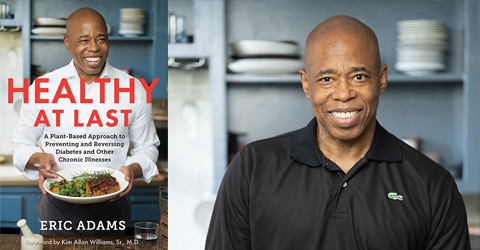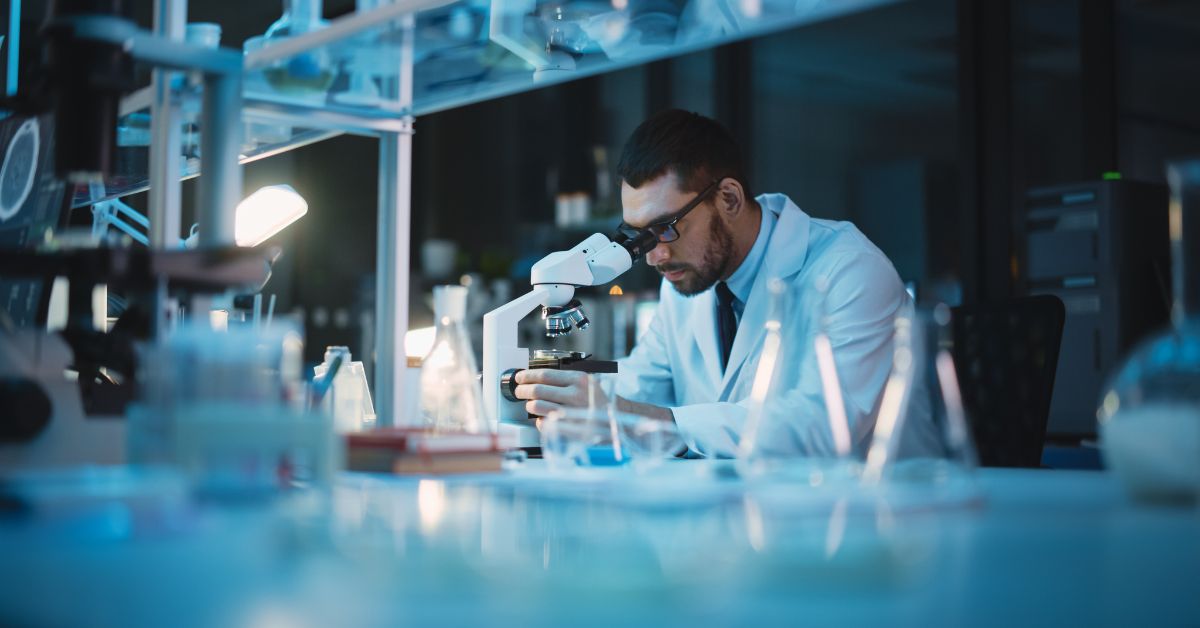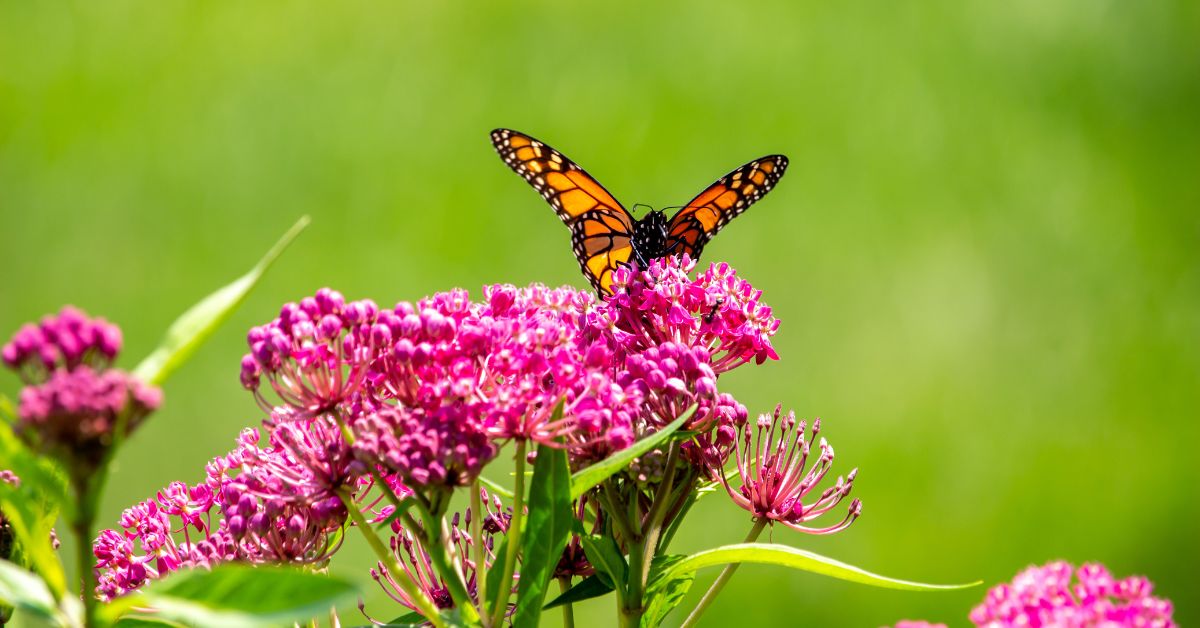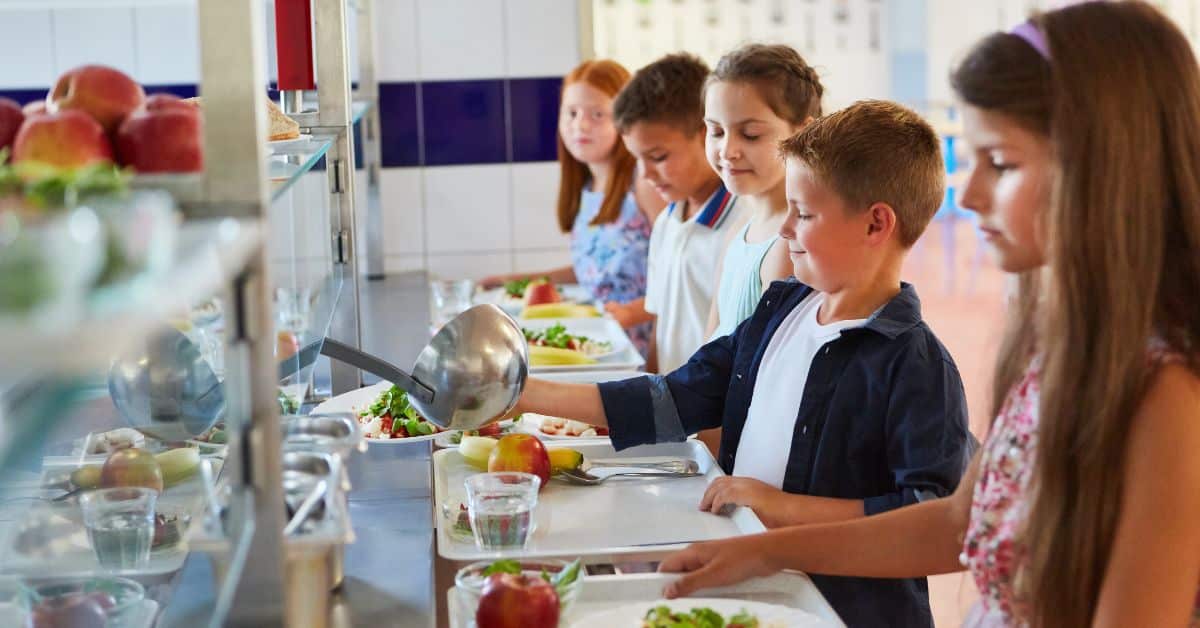
The following is an excerpt from Healthy at Last: A Plant-Based Approach to Preventing and Reversing Diabetes and Other Chronic Illnesses by Eric Adams (Hay House Inc., October 13, 2020).
In March 2016, life was good. I had the best job in the world: representing Brooklyn as borough president. I had just turned 56. I felt healthy. Maybe I was a bit overweight, but so were most people my age. I exercised regularly, and like all New Yorkers, I walked everywhere. I even got on the basketball court now and then.
I looked and felt fine—that is, until the day I woke up blind.
Terrified, I blinked my eyes rapidly, willing the world around me to come back into focus. Finally, I could barely make out the outline of my alarm clock. I stumbled to the mirror and saw, to my horror, that my right eye was bloodshot. I couldn’t see anything out of the left. My stomach felt like I had swallowed acid. I had spent 22 years as a New York City police officer patrolling violent neighborhoods, investigating homicides, and raiding drug dens, but none of that prepared me for the fear I felt that March morning.
I immediately went to my doctor’s office. The stomach pain turned out to be an ulcer, he explained, but my vision would probably be impaired for the rest of my life.
“Why?” I asked.
“Eric,” he said grimly. “I ordered an A1c test, the one that measures your blood sugar percentage. A normal level is between 4 and 5.6 percent. An A1c level over 6.5 means you have full-blown diabetes.”
“What’s my A1c level?” I asked.
The doctor cleared his throat. “Seventeen percent.”
Everything seemed to go numb. The kind of people who had A1c levels like that were wheelchair-bound and were taking regular insulin shots, or so I thought. I weighed 210 pounds—how could I be like them?
“Your high blood sugar damaged the blood vessels behind your eyes,” my doctor continued. “That’s what caused the vision loss.”
“There must be some mistake . . .” I stammered.
He shook his head. “With that A1c level, you’re lucky you’re not in a coma.” He whipped out his pad and prescribed insulin along with a battery of other medications. “Unfortunately diabetes is very common among African Americans, Eric. You’re going to have to get used to the meds. You’ll be on them for the rest of your life.”
Was I truly doomed to a short life because I happened to be a Black cop?
I wasn’t convinced. After scouring the web, I came across research by Dr. Caldwell Esselstyn, Jr. of the Cleveland Clinic, one of the best hospitals in the country. Thirty years earlier, he had taken 21 patients with severe heart disease and put them on something called a whole-food, plant-based diet. I didn’t know what that meant, so I googled it. Whole-plant foods are unprocessed and unrefined. Think of them as what you’d pluck off a vine or dig up in the ground. They don’t have added chemicals to turn them into Frankenstein foods, like potatoes into French fries or tomatoes into ketchup. They also don’t have ingredients taken away, like brown rice into white rice. Finally, as part of this diet and just as important, you couldn’t eat any animal products. No burgers, no fried chicken, no eggs, no dairy, no fish. I couldn’t even use cooking oils. In short: nothing I could get off the dollar menu.
I almost turned my computer off, but I had to know the answer: What happened to Dr. Esselstyn’s 21 patients after they gave up the kind of food I ate every day? Nearly all of them reversed their heart disease and avoided any further heart attacks. Their arteries, once clogged with plaque, healed themselves after cutting out animal products and processed foods.
Could it be that simple? I dug deeper. I came across research by Dr. Neal Barnard of the Physicians Committee for Responsible Medicine (PCRM). His team took patients with type 2 diabetes and fed them nothing but whole-plant foods. Within weeks, “participants saw dramatic health improvements,” Dr. Barnard reported. “They lost weight, insulin sensitivity improved, and HbA1c levels dropped. In some cases, you would never know they’d had the disease to begin with.”1
You would never know they’d had the disease to begin with? The more I read, the more excited I became. I could get off insulin. I could get off all the meds. I could wake up energized and excited for my day—something I hadn’t felt in many years. I could be healthy at last.
It wasn’t just my own health I was excited for. My mother had been living with diabetes for more than a decade and was experiencing chronic pain. My sister was prediabetic. I was worried about my girlfriend, Tracey, who had been diagnosed with prediabetes. She is a public-school administrator who oversees schools in Brooklyn and the Bronx. I have never met anyone more devoted to her job than Tracey. She was so devoted, in fact, that she sacrificed her own health for the sake of New York’s children. In addition to her prediabetes, she had had a hysterectomy for fibroids and was treated for anemia. At her most recent physical, her doctors warned her that A1c levels were on the rise. It wouldn’t be long before she was as sick as me. I asked Tracey if she wanted to embark on this journey with me. We do everything together, and I wasn’t ready to jump onboard unless she was.
“Let’s do it,” she said instantly.
Dr. Esselstyn generously agreed to speak with me on the phone, and he explained to me the science behind a whole-food, plant-based diet. He told me why meat, fish, eggs, dairy, and cooking oils had been slowly killing me for years, and how fruits, vegetables, whole grains, beans, nuts, seeds, and other whole-plant foods could reverse that damage and then some. “The human body is incredibly resilient,” he said, “if only we allow it to be.” I remained skeptical that I could ever enjoy eating this way, but I was determined to take charge of my health.
I replied, “Doctor, if this works for me, I’m going to encourage all my constituents to take control of their health just like I am now.”
THE (SHORT) ROAD TO HEALTH
A few weeks later, Tracey and I boarded a plane for Cleveland. At the seminar, I was no longer borough president of Brooklyn. I was no longer a future mayoral candidate of the country’s largest city. Rather, I was one of several hundred people who were suffering from chronic illness and desperate for a way to get healthy. I met people who had suffered three, four, five heart attacks and were wheeled around with oxygen tanks. There were folks who had been on insulin for decades and had terrible neuropathic pain in their hands and feet. Dr. Esselstyn’s wonderful wife, Ann, prepared plant-based dishes for us to sample. Tracey, who was used to a steady diet of soul food and McDonald’s, frowned and whispered to me, “What are we going to do, eat grass?”
It was like I was never diabetic at all. Decades of poor health habits and tens of thousands of Big Macs, chicken wings, and French fries—all reversed in a matter of months.
I poked at the dark leafy greens with my fork, wishing that a bed of cheesy grits were hiding underneath. But then I tasted the vegetable biryani, the roasted cauliflower with tahini sauce, the sliced avocados, the quinoa cakes. It was incredible. Tracey and I finished our plates and stared at each other. This was not the sad, old rice and beans we were expecting. This wasn’t the iceberg lettuce with tomatoes that we assumed vegans ate all the time. This wasn’t rabbit food. This food was delicious—and, according to Dr. Esselstyn, could also reverse my diabetes.
He said that type 2 diabetes is a lifestyle disease; it doesn’t happen unless we let it happen. When we gain weight from an unhealthy diet, fat builds up in our muscle cells, which blocks insulin from ferrying glucose to our cells. The problem is made worse when you eat a high-fat diet—that is, one with lots of meat and dairy. The fat from our food spills into our blood, further clogging up our muscle cells and preventing insulin from doing its job. Then Dr. Esselstyn told me that if I was able to remove fat from my body and animal fat from my food, I could reverse my diabetes entirely. Tracey could reverse her prediabetes. There was a possibility my 82-year-old mother could even reverse her diabetes.
When Tracey and I got home, we took a long, hard look at our kitchen. The cookies, the frozen pizzas, the snack foods. Tray after tray of ground beef, pork chops, and chicken breasts. A small mountain of Big Mac cartons in the recycling bin. A greasy bucket of leftover KFC. We looked at each other and groaned. How had we been eating this junk for so long?
Tracey and I aren’t people who do something halfway, so in one afternoon we tossed out every single unhealthy food in our kitchen. We tossed out all foods of animal origin. We tossed out processed snack foods. We tossed out sugary cereals and toaster pastries. Soft drinks and chocolate sandwich cookies. Beef jerky and cheese crackers. It was especially hard for Tracey, who emptied out food storage containers filled with her signature dishes. They were old favorites that made her think of her childhood, including the jambalaya with chicken that her mother used to make. The rice and hot smoked sausage recipe that’s been in the family for generations. By the time the dust settled, we had emptied nearly the entire contents of our kitchen into a dozen garbage bags. Then we went shopping.
Immediately I noticed our first problem: finding quality food. After work I used to hit up the local bodegas for quick meals and snacks, but none of them carried fruit and vegetables. The closest thing to potatoes were potato chips. The closest thing to strawberries were fruit snacks. The closest thing to whole grains were corn flakes. Fortunately, in my area of Brooklyn, there were grocery stores nearby that stocked the kinds of foods that Dr. Esselstyn said I needed to eat, including fresh fruits, in-season vegetables, brown rice, and other whole-plant foods. On Saturdays I could get locally sourced produce from the farmers’ market at Grand Army Plaza.
Except this wasn’t the case for hundreds of thousands of my constituents. My friends in Brownsville, East New York, and other lower-income neighborhoods farther along the 2 train were less fortunate. They were served by bodegas, deli markets, and fast-food restaurants exclusively. How could someone eat a whole-food, plant-based diet in food swamps like this?
But before I could make Brooklyn healthier, I had to make myself healthier. I had to prove that eating plant foods could reverse my diabetes and restore the vitality that had long since left my body. I had to look and act the change I wanted to impart in Brooklyn. The first week was incredibly tough. It took all my willpower not to duck into McDonald’s or KFC, or to hit up the food carts that were stationed next to Borough Hall. For years I had been their best customer. “Yo, Eric,” they’d call out. “No hot dog today? No chicken and rice?”
“Not today,” I’d say, jogging back to Borough Hall before I changed my mind. Instead it was a salad with black beans, tofu, tomatoes, and broccoli with tahini sauce back at my desk. When I was done with that, it was carrots and hummus. I snacked on edamame and trail mix. At 4 p.m., I had an apple and a banana. Whenever I was hungry, I simply ate more plants. Dr. Esselstyn assured me that eating plant based did not mean having to be hungry. Quite the contrary: I could eat as much food as I wanted and still lose weight and reverse my diabetes. It seemed too good to be true, but my stomach wasn’t about to disagree with him.
At dinner, Tracey and I rediscovered our love of cooking. I couldn’t make Mom’s old soul-food dishes anymore, but I could reinvent them. We made vegan pot pie with cornbread crust using coconut milk. Vegan macaroni and cheese with almond milk and nutritional yeast. Oil-free sweet potato casserole. Vegan gumbo with beans and okra.
Almost immediately, the extra fat on my body seemed to melt away. After a week, I hitched my belt one hole tighter. After two weeks, my suit pants fit like a baggy parachute and my jacket sagged around the shoulders. People began to notice my dramatic weight loss. My deputy borough president, Ingrid Lewis-Martin, took me aside one day. We had known each other since the 1980s, back when her husband and I were in the police academy together.
“Eric,” she said. “I’ll be honest: you don’t look so good. You know I love you like a brother, so be straight with me. Are you okay?”
“I’m doing very well,” I replied, explaining that I had lost the weight on a plant-based diet. I had been harming my body for so long that everyone had become used to an overweight version of me. An unhealthy version of me. A diabetic version of me. But because I was losing so much weight, my body wasn’t able to keep up. My skin was loose around my muscles. My eyes were sunken. And it didn’t help that I looked like a kid playing dress-up in his dad’s clothing. It was all temporary, and my body was still adjusting, but I felt healthier. I woke up with a spring in my step. I was no longer winded climbing the stairs of Borough Hall. I no longer felt exhausted by 3 P.M. Better yet, my vision cleared up entirely. Within two months of going plant based, I had shed 35 pounds.
When I returned to my original doctor, he looked at my new blood work and gasped. “Wow, Eric, I’ve never seen medication work this effectively before.”
“I stopped taking my meds a month ago,” I replied, grinning.
He stared at me. “I don’t see how that’s possible. Your A1c is below six. It’s like you were never diabetic at all.”
It was like I was never diabetic at all. Decades of poor health habits and tens of thousands of Big Macs, chicken wings, and French fries—all reversed in a matter of months.
Tracey was having similar results. She lost 30 pounds, and her A1c dropped so far that she was no longer prediabetic. Her cholesterol fell to normal levels. For years, she had suffered from exhaustion due to the stresses of her job. I thought being a cop for 20 years and running Brooklyn as borough president was hard, but that has nothing on what Tracey does. As a school administrator, she gets up at dawn to help run the largest school system in the United States. She never gets a break. Any doubts about eating plant based were put to rest when I’d see Tracey return from another 12-hour day still brimming with energy. Instead of collapsing on the couch, she’d asked, “What do you want to do tonight, Eric?”
Tracey and I were healthy at last. We had found a powerful tool and wielded it to heal our bodies. But something struck me as odd: Why did no one know about this? I had just reversed a disease that my doctor said was irreversible. And Dr. Esselstyn had cured dozens of people with end-stage heart disease. People who could barely walk. People who had suffered three, four, five heart attacks and were living on borrowed time. If it was that simple, that obvious, why wasn’t everyone eating a plant-based diet?
SPREADING THE WORD
After I became healthy at last, I thought about the promise I made to Dr. Esselstyn. If it worked for me, I told him, I’d devote my life to helping my constituents get healthy too. Nobody deserves to live with poor health when there is a simple and scientifically backed way to prevent, and often reverse, chronic disease.
In my capacity as Brooklyn borough president, I’m fighting to help New Yorkers of all colors, creeds, genders, and sexual orientations turn their health around like my mother, like Cliff, and like me. I’m working with hospitals and clinics to encourage doctors to disclose to their patients’ dietary options for heart disease, diabetes, and other chronic conditions. In January 2019, I was proud to help launch the Plant-Based Lifestyle Medicine Program in conjunction with NYC Health + Hospitals/Bellevue. The program is actively recruiting New Yorkers suffering from chronic conditions such as heart disease, diabetes, obesity, high cholesterol, and high blood pressure and improving their outcomes through healthful lifestyle changes—including, most importantly, eating a diet rich in fruits, vegetables, beans, and whole grains and absent of animal products and added sugars. We began with 200 patients, and the waiting list quickly swelled to more than 650. The demand was so overwhelming that we are fighting to expand the program to ensure every New Yorker striving to get healthy gets the help he or she needs.
The only thing more important than helping sick people get better is helping our children stay healthy for life. The onset of heart disease, diabetes, cancer, Alzheimer’s, and countless other chronic diseases begins in childhood, many decades before the first symptoms are noticed. I knew it was crucial to instill healthy eating habits in the next generation of New Yorkers, and that’s why I fought to institute meatless Mondays in all public city schools. In 2017, barely a year after I reversed my diabetes, I stood beside Mayor Bill de Blasio to announce that 15 schools in Brooklyn were adopting meatless Mondays. Less than 18 months later, the program spread to more than a million children at every school across the city.
Excerpted with permission from Healthy at Last: A Plant-Based Approach to Preventing and Reversing Diabetes and Other Chronic Illnesses by Eric Adams (Hay House Inc., October 13, 2020).
You Might Also Like
Copyright 2025 Center for Nutrition Studies. All rights reserved.
Deepen Your Knowledge With Our
Plant-Based Nutrition
Certificate
Plant-Based Nutrition Certificate
- 23,000+ students
- 100% online, learn at your own pace
- No prerequisites
- Continuing education credits














